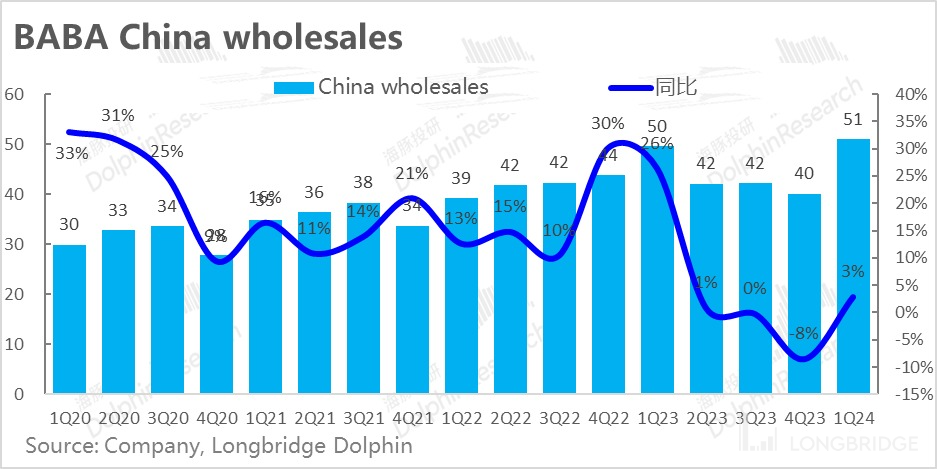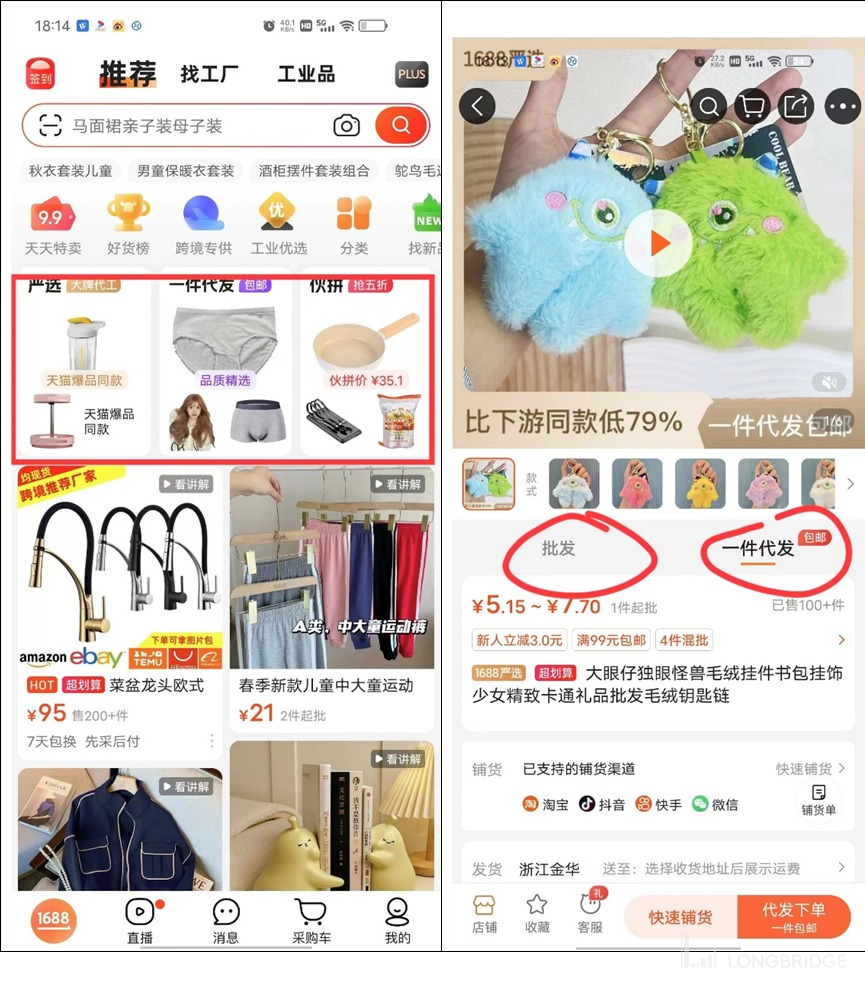1688 Select: "Smart" New Middle Class' Ultimate "Consumer Downgrading"?
Following the major changes in the upper echelons of Alibaba at the end of last year, there are three relatively niche markets that are transitioning from " little relevance" to "niche opportunities".
These three businesses are 1688, Xianyu, and DingTalk. Today, Dolphin Research will talk about one of these businesses-1688, based on recent observations.
1. Pressure on BABA‘s “old tree”
In Alibaba's vision of "making business easier worldwide," Alibaba's role is to help merchants sell their goods more easily, rather than eliminating channels.
The existence of 1688 is to facilitate the circulation of goods in the intermediate process before reaching end consumers. In the era before Pinduoduo, in the online wholesale field, 1688 served as a 24/7 online trade fair and an online Yiwu small commodity city. Although it did not experience high growth, it was still a contented presence.
However, the impact of the epidemic on offline stores and Pinduoduo's C2M model sweeping the sinking market by going directly from manufacturers to consumers have also swept away the original "wholesale-offline retail" channel system in recent years.
Together with the local small wholesale market, 1688 forms the "wholesale" link in the traditional channel system. Some people may still remember that before the rise of Pinduoduo in 2017 and 2018, it was difficult for online-to-C retail to penetrate the sinking market. Alibaba's B-series business created the "Retail Pass" new channel system and Rural Taobao. However, when Pinduoduo directly penetrated the sinking market with the to-C approach, most of the to-B business models ended up with little success.
Therefore, when Pinduoduo removed the middleware and directly sold to C-end users at the wholesale price of 1688, a large number of offline customers of 1688 were eliminated.
However, Pinduoduo's C2M approach, by converting 1688 customers (retailers) into online shoppers, partially eroded end demand at the front end and bypassed the intermediate channel circulation link to connect directly with factories. It still exerted a significant suppressive effect, fundamentally encroaching on 1688's market.
Of course, the Taobao Factory("Taogongchang") jointly developed by 1688 and Taobao has to some extent transformed online wholesale business into online retail. However, the current scale of Pinduoduo demonstrates the result of competition.

In fact, as early as 2017, when Dolphin Research was studying Pinduoduo, it noticed that while Pinduoduo was already playing with B2C low-priced group orders, there was only one difference between the B2B model of 1688 and retail, which was "free shipping." If 1688 did not transform, Pinduoduo could have a significant impact.
2. Late transformation: "Free Shipping" & "to C"
Against this backdrop of business competition, Dolphin Research finally sees the late transformation of 1688 after the changes in Alibaba's top management. The core of this transformation, in a few words, is "to C". This is reflected in several key features:
The three major modules on the homepage of the app - Yanxuan, One-piece Delivery (Free Shipping), and Flash Sale.
The direct effect of these three modules is that in the past, 1688 could only sell to small businesses, but now C-end users who usually only buy one or two items can also make purchases. Even under the wholesale purchase option, C-end users can also make purchases through the "mix and match" mode with the same product but different SKUs.

Behind this feature is the "full-service" business model iteration that has been booming in the retail industry this year. However, in 1688, full-service came early, and it was called "Factory Goods Channel".
Under the original full-service model of the Factory Goods Channel, factories without the ability to operate goods such as traffic, marketing, and C-end delivery could only provide goods and let e-commerce platforms handle marketing and sales.
Unlike the full-service model for C-end, at that time, in addition to the platform and factories, there was also a distributor. The role of the distributor was mainly to do offline promotion work such as factory bidding and to operate marketing after the goods were listed on the platform. The commission for the transaction volume was shared between the platform and the operating agent.
However, in September 2022, after each business line began to seek its own development path, the original Factory Goods Channel of 1688 became the current "1688 Yanxuan", and the role of the distributor in the transformation was weakened.
3. Three Key Questions about 1688 Yanxuan
1688 Yanxuan (1688 Select) is a new channel of 1688 under the full-service model, which allows small B to purchase and also allows small C to place orders for a single item, and the source of goods is more carefully selected.
1) Where does 1688 Yanxuan source its goods from?
In terms of categories, the main ones are standard products and quasi-standard products. The core focus of standard products is office supplies, department stores, home decoration lighting, home textiles, sports and outdoor categories, while quasi-standard products include shoes and bags.
The word "Yanxuan" mainly reflects:
a) Selection of factories: Core merchants such as brand OEM factories, followed by well-known brands in industrial belts, at least with TM and R marks; and then brand original factories that integrate manufacturing and trade or brand and factory.
b) Selection of products: A standard is defined around "quality/price/service", such as having good response speed, service capability, performance capability, and price competitiveness. There are online rules and thresholds that need to be met, and only products that meet the standards can be included.
There are already over 10,000 flagship stores of Yanxuan brands.
2) Who are the users of 1688 Yanxuan?
There are three main categories: advanced small B (small and medium-sized retailers), potential small B (start-up or struggling users), and potential buyers (household or personal use).
a) Advanced small B: Includes physical stores (such as offline clothing stores), platform e-commerce sellers (such as Taobao sellers), content/social e-commerce sellers (sellers on platforms like Douyin, Kuaishou, and WeChat), cross-border e-commerce sellers, and enterprise self-procurement, etc.b. Small potential b: This refers to startups or businesses that are relatively small in scale or are in a state of fluctuation between operation and self-use. Although their individual purchase amounts are not as high as those of advanced small b, their frequency and repurchase rates are very good. Examples include our defined target audience of professional men and women, who make large household purchases and also have some business attributes. This category also includes young men and women, making up the four major groups.
c. Potential buyers: This mainly refers to potential customers or high-net-worth individuals who have a primary demand for personal use. They are mostly young white-collar workers who have just entered the workforce, college students, and other similar groups. Many of them come from platforms like Xiaohongshu (Little Red Book) and have a consumer-oriented profile, forming another category.
d. Overall buyer profile: This refers to the quality and personalized purchasing or consumption needs of users aged 25 to 35 in first and second-tier cities. They belong to the rational consumption generation of the "Z-generation" who focus on "wanting everything except the logo, and preferably with some added value."
It also includes the new middle class aged 30-35 who are shy about getting married and having children, and are focused on achieving "five goals" -still on the way to make a better life on career, knoledge, housing, parents, and children.
These two categories currently account for over 90% of the users on 1688 Select.
3) How does 1688 Yanxuan monetize?
The monetization model of 1688 Select follows the traditional platform e-commerce approach:a) Transaction service fees, similar to the commission on Tmall, are deducted from the transaction amount.b) Advertising fees paid by factories and manufacturers to promote their products on the platform.
Difference from Taogong Factory: The backend operations are similar, but the main difference lies in the frontend product selection. Taogong Factory emphasizes low-priced products, while 1688 Select focuses on quality and personalized products in the standard and semi-standard categories. Of course, since they are factory products, price competitiveness is also emphasized.
Difference from Netease Yanxuan: Netease Yanxuan rebrands factory products under the "Netease Yanxuan" label and operates as a self-owned 1P business. 1688 Select, on the other hand, operates under a fully managed 3P model.
4. Can the new sprout on the old tree rebuild 1688?
To be honest, Dolphin Research is not sure whether this new sprout of 1688 Select can grow into a B2C version of 1688. From the current transformation, 1688 Yanxuan has opened its doors to do business and does not reject small fragmented orders.
However, the ultimate outcome depends on the balance of the overall strategy. After all, to truly engage in B2C business, there usually needs to be a substantial investment process.
But at least, the transformation of 1688 from a relatively vertical and increasingly narrow track is a positive signal.
Risk Disclosure and Disclaimer for this article: Dolphin Research Disclaimer and General Disclosure





